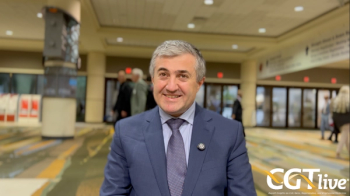
Upstaza Approved by European Commission for AADC Deficiency
The gene therapy received a positive CHMP opinion in May 2022.
This content originally appeared on our sister site,
The European Commission has granted
The marketing authorization for Upstaza, the first disease-modifying therapy approved for the rare disorder, is applicable to all 27 European Union member states, as well as Iceland, Norway, and Liechtenstein. Upstaza, a recombinant adeno-associated virus serotype 2-based gene therapy, is approved for patients 18 years or older with a clinical, molecular, and genetically confirmed diagnosis of AADC deficiency.
"[This] approval from the European Commission for Upstaza for the treatment of AADC deficiency is momentous for patients, for PTC, as well as for the larger gene therapy community,” Stuart Peltz, PhD, chief executive officer, PTC Therapeutics, said in a statement.1 "We are proud to bring this innovative therapy to the marketplace so that patients may benefit. Upstaza is the first and only approved disease-modifying treatment for patients living with AADC deficiency. We are ready to deliver this long-awaited treatment to patients as soon as possible."
AADC deficiency is a fatal, rare genetic disorder that typically causes severe disability and suffering from the first months of life, leading to decreased muscle tone, movement disorders, and disruption of the autonomic nervous system.
Eladocagene exuparvovec has demonstrated its efficacy and safety across multiple clinical trials and compassionate use programs. Data from phase 1/2 clinical trials of Upstaza (NCT01395641; NCT02926066) published in Molecular Therapy in February 2022 demonstrated that treated patients reached clinically meaningful developmental milestones not seen in the natural history of the disease.2 Cognitive and motor skill improvements have persisted for up to 10 years after treatment.
WATCH NOW:
As early as 12 months after treatment, 44% of patients achieved head control and 20% of subjects could sit unassisted. At 24 months post-treatment, 64% of individuals achieved head control, 50% could sit unassisted, and 18% could stand without support. After 60 months post-treatment, 75% of subjects achieved head control, 67% of patients could sit unassisted, 25% of the cohort could stand without support, and 8% of individuals could walk with support. In contrast, only 4% of the individuals from the Natural History Database (NHDB) (n = 49) achieved key milestones (P <.0001).
"Before treatment, our daughter had not met any development milestones. She suffered from oculogyric crises that evolved into hours of pain, and we were told she would be bedridden for life," Richard Poulin, founder, Teach RARE, whose daughter was treated as part of a clinical trial, added to the statement.1 "After receiving Upstaza, she is now speaking, walking, running, and even riding horses. We're thrilled with the EMA approval and the hope that this milestone brings to other children and families impacted by AADC deficiency."
In May 2022, a post hoc analysis of 3 trials showed that eladocagene exuparvovec improved body weight and reduced respiratory infections in patients with AADC deficiency.3 At baseline, 83.3% (20 of 24) of patients had body weight in the bottom third percentile; however, after 12 months of treatment, 95.9% maintained or gained weight relative to age- and gender-matched children without AADC deficiency; 42% (10 of 24) shifted to a higher percentile, and 54% (13 of 24) maintained the same percentile as at baseline. Additionally, the annual rate of upper respiratory tract infections and pneumonia decreased from 2.41 at 1 year after treatment to 0.31 at 5 years after treatment.
Although the European marketing authorization is a big step forward in treating AADC deficiency, many unmet needs remain in the affected population. CGTLive previously spoke with study investigator Paul Wuh-Liang Hwu, MD, PhD, professor, National Taiwan University Hospital, about these unmet needs.
"Similar to muscle biopsy for Pompe's disease, the standard diagnosis for AADC deficiency is lumbar puncture, a specific type of lumbar puncture that only 1 or 2 labs in in each state. So, it's a huge obstacle in the diagnosis of this disease. There are certainly many patients with AADC deficiency that are not diagnosed,"
REFERENCES
1. Upstaza granted marketing authorization by European Commission as first disease-modifying treatment for AADC deficiency. News release. PTC Therapeutics. July 20, 2022. Accessed July 20, 2022. https://www.prnewswire.com/news-releases/upstaza-granted-marketing-authorization-by-european-commission-as-first-disease-modifying-treatment-for-aadc-deficiency-301589884.html
2. Tai CH, Lee NC, Chien YH, Byrne BJ, Muramatsu SI, Tseng SH, Hwu WL. Long-term efficacy and safety of eladocagene exuparvovec in patients with AADC deficiency. Mol Ther. 2022;30(2):509-518. doi:10.1016/j.ymthe.2021.11.005
4. Hwu P, Chien Y, Tseng S, Wang A, Schilling T, Tai C. Eladocagene exuparvovec improves body weight and reduces respiratory infections in patients with aromatic L-amino acid decarboxylase deficiency. Neurology. 2022;98(18 supplement).
Newsletter
Stay at the forefront of cutting-edge science with CGT—your direct line to expert insights, breakthrough data, and real-time coverage of the latest advancements in cell and gene therapy.

















































